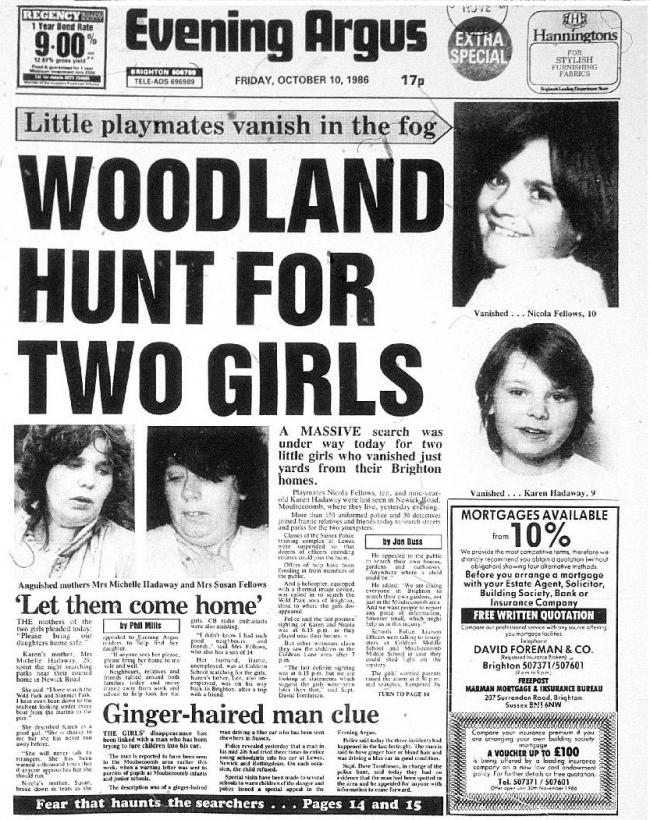THE archives for the Evening Argus are stored at The Keep, just a short walk from where Nicola Fellows and Karen Hadaway were found in Wild Park in Brighton.
A glimpse back reveals how the story dominated headlines through 1986 and 1987, and our former reporters Kate Parkin and Phil Mills have spoken about their memories of the events.
On the Wednesday before the girls disappeared, the front page headline in the Evening Argus was far more mundane, with Tory Health Minister Norman Fowler pledging a crackdown on operations in hospitals.
Airlines were trying to tackle boozy passengers at Gatwick, the pound plunged to a new low, and there was a cash crisis for a leading cancer charity.
Pervert
The paper cost 17 pence, and included a TV and radio round-up on page five, listing popular programmes such as EastEnders and Tomorrow’s World.
On the day the girls went missing, our front was about a potential pervert trying to lure children into his car across Sussex. The story influenced our coverage, as he was touted as a possible suspect for the murders.

Then on Friday, October 10, we reported on the desperate hunt to find the girls.
Phil Mills, who joined the Evening Argus in 1980, interviewed Karen Hadaway’s mother Michelle. He said: “She was engulfed in worry and dread. She could not sit or stand in one place for more than a few seconds, constantly wandering outside to look both ways for her daughter.
“There was the hope the girls had just gone on an adventure, and would turn up alive and well, and Michelle was hoping Karen would turn a corner and run into her arms.”
Phil reported that 150 uniformed officers and 30 detectives joined the search, along with hundreds from the community. Even a search helicopter with the latest thermal image technology was scrambled.

But that afternoon, the grim discovery of the girls’ bodies was made. Reports from the time show the disbelief, but also the simmering anger that such a horrific crime could be committed. Phil said: “This was the most heinous crime any living person could recall.”
In the days that followed, we reported on the search for the killer. There was speculation about a sex pest luring children into his car, and reports of two youths seen leaving Wild Park which hit the headlines.
New reporter Kate Parkin was sent to Moulsecoomb, and reported how the playgrounds and streets were empty, as children were kept indoors.
She said: “Reading it back now I can remember it all in detail. Back in those days the newspaper had three editions – in the morning, lunchtime and evening.
“The Argus was how people got their news back then and people were flocking to read about what happened.”

We reported how there were tears, anger and fear. Children at Moulsecoomb Middle School walked in pairs, and council meetings were called to discuss how to improve the safety of all parks in Brighton. Meanwhile there was talk of revenge on the estate, while at memorial services there were pleas for calm.
The Argus asked: Who is the Monster? We wrote that perhaps the killer was going about his normal routine or perhaps he was running scared like an animal. “There is a killer in our midst, a monster who may strike again,” we wrote.
Donations to a fund for the girls reached £10,000 and we interviewed Nicola’s father Barrie Fellows, who said: “I’m likely to explode at any moment.”
A week after the girls had disappeared, the story was still front page news. Tracey Cox was the last witness to see them alive, apart from the killer. She said: “I’ll always remember them standing at the corner, waving to me.” Tracey said she tried to get the girls to go home for their tea, but they had ignored her and crossed the road into Wild Park. She said: “They were cheeky girls, always playing around, they were just two normal little girls.”
Teenagers Matthew Marchant and Kevin Rowland found the bodies. Kevin, who was then a hospital porter, said: “I see bodies every day at the hospital, but this really shook me.”
As regards the potential killer he added: “Hanging is too good for him.”

We reported on the Crimewatch television reconstruction, and police told us it was the case they all wanted to crack. Ten-year-old Lianne Martin from Stanmer and nine-year-old Katrina Taylor from Bolney Avenue in Moulsecoomb took part in the reconstruction. Katrina had been in the same class as Nicola.
By this point, there was the belief they were not looking for the pest who was trying to lure children into cars, but somebody local. There were more than 90 detectives working on the case, and 18,000 had been quizzed. We also reported on the pressure the police were under, with several other murder investigations under way in Sussex.
Death penalty
As it entered the third week, the news started to move off the front page, but there was outrage when a Conservative county councillor had blamed the parents for the tragedy. Meanwhile mums Catherine Evans and Jackie Gray set up a stall outside Churchill Square calling for the death penalty to be reinstated.
There were some strange developments, such as the arrival of millionaire Arab Dr Shamsudin Alfasi, who donated £5,000 to the reward fund. He arrived on the Moulsecoomb estate in a “gleaming Rolls-Royce”, and the Argus reporters, perhaps a little baffled, described how he wore “Eastern dress”. Dr Alfasi said: “I come here as a father to offer my condolences.”
Then on Monday, November 3, 1986, The Argus carried an exclusive interview from the mother of an unnamed suspect. The arrested man was living in hiding, and had spent 51 hours in police custody being grilled by detectives. He had been freed the previous day and was living in London.
Around the same time, The Argus launched a stranger danger campaign, with thousands of badges handed out to school children. There were also police visits to schools to warn of “stranger danger”.

But it was only by December that the unnamed suspect was revealed as Russell Bishop. An interview with his girlfriend Marion Stevenson revealed that she felt the pressure of the state turning against her and her family. “My world fell apart the day they were found,” she said.
Then on December 4, Bishop made his first of many court appearances. In a seven minute hearing at Hove. He was represented by solicitor Ralph Haeems, the lawyer who had represented the Krays.
Bishop was held in custody over Christmas, and could not see Jenny Johnson his common law wife, who was pregnant with his second child.
Her “nightmare” was revealed in an article in January with newborn Hayley.
She did not believe Bishop was guilty, and said: “I will wait for him, no matter how long it takes.”
At the same time, Brighton and the country endured the big freeze of January and February 1987, as snow flurries hit.
Bishop was appearing at Hove for an “old style” committal hearing before magistrates, to see if there was a case to answer.

Kate Parkin covered the case alongside her colleague Jim Hatley each day.
Kate said: “I can remember every tiny detail about it, it dominated my life. We took it in turns – one of us sat in court taking notes while the other filed copy and then we swapped places.
“We covered every word of the case verbatim, filing our stories to a copytaker using the pay phone in the court – we didn’t have mobiles then.”
It was here that first details about the girls’ ordeal was revealed, as well as key pieces of evidence such as the blue Pinto sweatshirt.
It was around this time the scene in Moulsecoomb turned ugly. The Argus received a warning letter telling the Bishop family and Jennie Johnson to get out of Brighton, threatening fire bombings.
The funeral for the girls was held on February 4, and the girls were buried at Bear Road Cemetery.
Bishop’s application for bail was refused, as magistrates feared for his safety. Reports suggest there was a cold fog over Brighton, and only the sound of tears could be heard. The families held each other in grief. Single roses were laid at the graves.
On February 6, the home of a couple accused of stealing funds from the Wild Park Tragedy Appeal was gutted in an arson attack. They appeared in court accused of stealing £700, but the firebombing led to appeals for calm on the estate that was simmering with anger.
It was confirmed Bishop was to face a trial at Lewes Crown Court, which then began in the autumn of 1987.
We led a front page with the prosecution describing the crime scene. The girls were murdered in a “cave of tangled undergrowth by someone they knew”.
The scene had changed only weeks before when Britain was lashed by the great storm of 1987, which forecaster Michael Fish had famously dismissed as not being a hurricane.Trees at Wild Park were uprooted and the undergrowth had changed dramatically.

The trial had to be restarted with a new jury sworn in after one juror became ill, adding to the delays and leading the trial into late November and December 1987.
We reported that the girls had been banned from speaking to Bishop and from going into Wild Park alone. Bishop’s contradictory account, and his lies, was also picked up on, and his refusal to go in the dock was seen as a sign of his guilt.
But the hopes for justice to be done were thwarted and we reported that there was “uproar” when a not guilty verdict was read out.
Kate said: “There was shock when Bishop got off. It took the jury just two hours to find him not guilty – but everyone knew it was him.”
Indeed, a police statement effectively said there were “no plans to reopen this inquiry”, confirming the force’s belief that Bishop, and Bishop alone, was the right man.
In the dock the defendant sobbed, but his family cheered, and one of brothers even tried to vault over seats to get into the dock to celebrate.
Days later, Bishop spoke to The Argus and pledged to build a new life in 1988. Grinning at home with his parents he vowed to marry Jennie Johnson and find work. The 30-year battle for justice for Nicola and Karen had begun.























Comments: Our rules
We want our comments to be a lively and valuable part of our community - a place where readers can debate and engage with the most important local issues. The ability to comment on our stories is a privilege, not a right, however, and that privilege may be withdrawn if it is abused or misused.
Please report any comments that break our rules.
Read the rules here